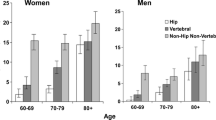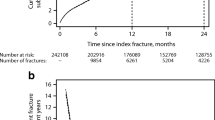Abstract
Summary
The overall incidence of imminent fracture after a prior fragility fracture was 7.58% in the first year and 11.58% in the first 2 years. Approximately half of re-fractures occurred in the first 2 years after a fragility fracture. Older patients that have suffered from a fragility fracture should be treated promptly, with immediate care and a secondary fracture prevention to prevent the high imminent risk of a fracture.
Introduction
Imminent fractures refer to the fractures that occur within 2 years of an initial fracture. It is well known that the risk of a subsequent fracture is not constant with time and occurs shortly after the initial one. This systematic review and meta-analysis aimed to present the existing data on imminent fracture worldwide.
Methods
Literature search was conducted in Pubmed, Embase, and Web of Science databases until 26 October 2021 for studies reporting the incidence of imminent osteoporotic fractures among people aged 50 years or older. The overall incidence of imminent fracture was pooled and subgroup analyses of index fracture sites and regions on incidence of imminent fracture were performed, with the 95% confidence interval (CI) being calculated. Percentage of imminent fracture occurring in follow-up period was calculated and pooled by meta-analysis. Hazard ratio (HR) was used to estimate the gender differences on the imminent risk of fracture.
Results
A total of 1446 articles were identified. Nineteen observational studies were eligible for our systematic review, in which 18 were used for quantitative analysis. Pooled overall incidence of imminent fracture in the first year after an osteoporotic fracture was 7.58% (95% CI 5.84 to 9.31%) and cumulative incidence in the first 2 years was 11.58% (95% CI 8.94 to 14.21%). Subgroup analysis showed that in the first 2 years, the pooled incidence in Asia was 7.30% (95% CI 3.42 to 11.18%), whilst incidence in Europe/North America was 13.17% (95% CI 10.14 to 16.20%). In included studies with follow-up period of more than 5 years, pooled imminent fracture percentage in the first 2 years was 47.24% (95% CI 26.18 to 68.30%). Hazard ratio (HR) on gender showed that women had an overall slight increase in risk of imminent fractures (HR 1.18, 95% CI 1.11 to 1.25).
Conclusion
The incidence of imminent fracture is high globally at 11.58%. Approximately half of all refractures occur in the first 2 years after an index fragility fracture. Older patients that have suffered from a fragility fracture should be treated promptly. Also, immediate care and secondary fracture prevention are necessary to prevent the high imminent risk of a fracture, especially within the first 2 years.






Similar content being viewed by others
References
Black DM, Rosen CJ (2016) Clinical practice. Postmenopausal osteoporosis. N Engl J Med 374:254–262. https://www.ncbi.nlm.nih.gov/pubmed/26789873
Johnell O, Kanis JA (2006) An estimate of the worldwide prevalence and disability associated with osteoporotic fractures. Osteoporos Int 17:1726–1733. https://www.ncbi.nlm.nih.gov/pubmed/16983459
Lewiecki EM, Ortendahl JD, Vanderpuye-Orgle J, Grauer A, Arellano J, Lemay J, Harmon AL, Broder MS, Singer AJ (2019) Healthcare policy changes in osteoporosis can improve outcomes and reduce costs in the United States. JBMR Plus 3:e10192. https://www.ncbi.nlm.nih.gov/pubmed/31667450
Curtis EM, Moon RJ, Dennison EM, Harvey NC, Cooper C (2016) Recent advances in the pathogenesis and treatment of osteoporosis. Clin Med (Lond) 16:360–364. https://www.ncbi.nlm.nih.gov/pubmed/27481382
Bliuc D, Nguyen ND, Milch VE, Nguyen TV, Eisman JA, Center JR (2009) Mortality risk associated with low-trauma osteoporotic fracture and subsequent fracture in men and women. JAMA 301:513–521. https://www.ncbi.nlm.nih.gov/pubmed/19190316
Wong RMY, Choy MHV, Li MCM, Leung KS, S KHC, Cheung WH, Cheng JCY (2018) A systematic review of current osteoporotic metaphyseal fracture animal models. Bone Joint Res 7:6–11. https://www.ncbi.nlm.nih.gov/pubmed/29305425
Roux C, Briot K (2017) Imminent fracture risk. Osteoporos Int 28:1765–1769. https://www.ncbi.nlm.nih.gov/pubmed/28236126
Wong RMY, Ho WT, Wai LS, Li W, Chau WW, Chow KS, Cheung WH (2019) Fragility fractures and imminent fracture risk in Hong Kong: one of the cities with longest life expectancies. Arch Osteoporos 14:104. https://www.ncbi.nlm.nih.gov/pubmed/31659457
Sattui SE, Saag KG (2014) Fracture mortality: associations with epidemiology and osteoporosis treatment. Nat Rev Endocrinol 10:592–602. https://www.ncbi.nlm.nih.gov/pubmed/25091729
Wu CH, Tu ST, Chang YF, Chan DC, Chien JT, Lin CH, Singh S, Dasari M, Chen JF, Tsai KS (2018) Fracture liaison services improve outcomes of patients with osteoporosis-related fractures: a systematic literature review and meta-analysis. Bone 111:92–100. https://www.ncbi.nlm.nih.gov/pubmed/29555309
Pinedo-Villanueva R, Charokopou M, Toth E, Donnelly K, Cooper C, Prieto-Alhambra D, Libanati C, Javaid MK (2019) Imminent fracture risk assessments in the UK FLS setting: implications and challenges. Arch Osteoporos 14:12. https://www.ncbi.nlm.nih.gov/pubmed/30712158
Malle O, Borgstroem F, Fahrleitner-Pammer A, Svedbom A, Dimai SV, Dimai HP (2021) Mind the gap: incidence of osteoporosis treatment after an osteoporotic fracture - results of the Austrian branch of the International Costs and Utilities Related to Osteoporotic Fractures Study (ICUROS). Bone 142:115071. https://www.ncbi.nlm.nih.gov/pubmed/31593822
Adachi JD, Brown JP, Schemitsch E, et al. (2021) Fragility fracture identifies patients at imminent risk for subsequent fracture: real-world retrospective database study in Ontario, Canada. BMC Musculoskelet Disord 22:224. https://www.ncbi.nlm.nih.gov/pubmed/33637078
Hadji P, Schweikert B, Kloppmann E, Gille P, Joeres L, Toth E, Möckel L, Glüer CC (2021) Osteoporotic fractures and subsequent fractures: imminent fracture risk from an analysis of German real-world claims data. Arch Gynecol Obstet 304:703–712
Liberati A, Altman DG, Tetzlaff J, Mulrow C, Gotzsche PC, Ioannidis JP, Clarke M, Devereaux PJ, Kleijnen J, Moher D (2009) The PRISMA statement for reporting systematic reviews and meta-analyses of studies that evaluate health care interventions: explanation and elaboration. PLoS Med 6:e1000100. https://www.ncbi.nlm.nih.gov/pubmed/19621070
Wells GA SB, O’Connell D, Peterson J, Welch V, Losos M, Tugwell P (2010) The Newcastle-Ottawa Scale (NOS) for assessing the quality of nonrandomised studies in meta-analyses
Johnell O, Kanis JA, Odén A, Sernbo I, Redlund-Johnell I, Petterson C, De Laet C, Jönsson B (2004) Fracture risk following an osteoporotic fracture. Osteoporos Int 15:175–179
Luthje P, Helkamaa T, Kaukonen JP, Nurmi-Luthje I, Kataja M (2012) A long-term follow-up of 221 hip fracture patients in southeastern Finland: analysis of survival and prior or subsequent fractures. Arch Gerontol Geriatr 54:E294-E299. <Go to ISI>://WOS:000302959400008
Omsland TK, Holvik K, Meyer HE et al (2012) Hip fractures in Norway 1999–2008: time trends in total incidence and second hip fracture rates. A NOREPOS study. Eur J Epidemiol 27:807–814. <Go to ISI>://WOS:000310891300006
Wustrack R, Seeman E, Bucci-Rechtweg C, Burch S, Palermo L, Black DM (2012) Predictors of new and severe vertebral fractures: results from the HORIZON Pivotal Fracture Trial. Osteoporos Int 23:53–58
Chen CW, Huang TL, Su LT, Kuo YC, Wu SC, Li CY, Chen KB, Sung FC (2013) Incidence of subsequent hip fractures is significantly increased within the first month after distal radius fracture in patients older than 60 years. J Trauma Acute Care Surg 74:317–321
Omsland TK, Emaus N, Tell GS, et al. (2013) Ten-year risk of second hip fracture. A NOREPOS study. Bone 52:493–497. <Go to ISI>://WOS:000312750700058
Gibson-Smith D, Klop C, Elders PJM, Welsing PMJ, van Schoor N, Leufkens HGM, Harvey NC, van Staa TP, de Vries F (2014) The risk of major and any (non-hip) fragility fracture after hip fracture in the United Kingdom: 2000–2010. Osteoporosis International 25:2555–2563. <Go to ISI>://WOS:000344167500005
Johansson H, Siggeirsdottir K, Harvey NC, Oden A, Gudnason V, McCloskey E, Sigurdsson G, Kanis JA (2017) Imminent risk of fracture after fracture. Osteoporos Int 28:775–780. https://www.ncbi.nlm.nih.gov/pubmed/28028554
Sabapathippillai S, Lekamwasam S (2018) Prior fracture and refracture among patients admitted with hip fracture: data from a regional hip fracture registry in Sri Lanka. Int J Rheum Dis 21:2119–2121. <Go to ISI>://WOS:000456873700011
Balasubramanian A, Zhang J, Chen L, Wenkert D, Daigle SG, Grauer A, Curtis JR (2019) Risk of subsequent fracture after prior fracture among older women. Osteoporos Int 30:79–92
Park SM, Ahn SH, Kim HY, Jang S, Ha YC, Lee YK, Chung HY (2020) Incidence and mortality of subsequent vertebral fractures: analysis of claims data of the Korea National Health Insurance Service from 2007 to 2016. Spine J 20:225–233
Toth E, Banefelt J, Åkesson K, Spångeus A, Ortsäter G, Libanati C (2020) History of previous fracture and imminent fracture risk in Swedish women aged 55 to 90 years presenting with a fragility fracture. J Bone Miner Res 35:861–868
Jung HS, Jang S, Chung HY, Park SY, Kim HY, Ha YC, Lee YK, Nho JH (2021) Incidence of subsequent osteoporotic fractures after distal radius fractures and mortality of the subsequent distal radius fractures: a retrospective analysis of claims data of the Korea National Health Insurance Service. Osteoporos Int 32:293–299. <Go to ISI>://WOS:000566411200001
Khalid S, Reyes C, Ernst M, Delmestri A, Toth E, Libanati C, Abrahamsen B, Prieto-Alhambra D (2021) One- and 2-year incidence of osteoporotic fracture: a multi-cohort observational study using routinely collected real-world data. Osteoporos Int
Roux C, Thomas T, Paccou J, Bizouard G, Crochard A, Toth E, Lemaitre M, Maurel F, Perrin L, Tubach F (2021) Refracture and mortality following hospitalization for severe osteoporotic fractures: the Fractos study. JBMR Plus 5:e10507
Pike CT, Birnbaum HG, Schiller M, Swallow E, Burge RT, Edgell ET (2011) Prevalence and costs of osteoporotic patients with subsequent non-vertebral fractures in the US. Osteoporos Int 22:2611–2621
Iconaru L, Moreau M, Baleanu F, et al. (2021) Risk factors for imminent fractures: a substudy of the FRISBEE cohort. Osteoporos Int 32:1093–1101. https://www.ncbi.nlm.nih.gov/pubmed/33411010
Park JA, Nam JH, Hong SH, Shim YB, Jeong J, Shin JY (2020) Economic burden of subsequent fracture in osteoporosis patients in South Korea. J Med Econ 23:1598–1605. https://www.ncbi.nlm.nih.gov/pubmed/33001716
Ho-Le TP, Tran TS, Bliuc D, Pham HM, Frost SA, Center JR, Eisman JA, Nguyen TV (2021) Epidemiological transition to mortality and refracture following an initial fracture. Elife 10:https://www.ncbi.nlm.nih.gov/pubmed/33558009
Schnell AD, Curtis JR, Saag KG (2018) Importance of recent fracture as predictor of imminent fracture risk. Curr Osteoporos Rep 16:738–745
Camacho PM, Petak SM, Binkley N, et al. (2020) American Association of Clinical Endocrinologists/American College of Endocrinology clinical practice guidelines for the diagnosis and treatment of postmenopausal osteoporosis-2020 update. Endocr Pract 26:1–46. https://www.ncbi.nlm.nih.gov/pubmed/32427503
Kanis JA, Harvey NC, McCloskey E et al (2020) Algorithm for the management of patients at low, high and very high risk of osteoporotic fractures. Osteoporos Int 31:1–12. https://www.ncbi.nlm.nih.gov/pubmed/31720707
Bouxsein ML, Eastell R, Lui LY et al (2019) Change in bone density and reduction in fracture risk: a meta-regression of published trials. J Bone Miner Res 34:632–642. https://www.ncbi.nlm.nih.gov/pubmed/30674078
Wong RMY, Ko SY, Chau WW, Lee LCY, Chow SKH, Cheung WH, Law SW (2021) The first reported fracture liaison service (FLS) for vertebral fractures in China: is muscle the missing gap? Arch Osteoporos 16:168
Kirk B, Zanker J, Duque G (2020) Osteosarcopenia: epidemiology, diagnosis, and treatment-facts and numbers. J Cachexia Sarcopenia Muscle 11:609–618
Walters S, Khan T, Ong T, Sahota O (2017) Fracture liaison services: improving outcomes for patients with osteoporosis. Clin Interv Aging 12:117–127. https://www.ncbi.nlm.nih.gov/pubmed/28138228
Kanis JA, Johansson H, Harvey NC et al (2021) The use of 2-, 5-, and 10-year probabilities to characterize fracture risk after a recent sentinel fracture. Osteoporos Int 32:47–54. https://www.ncbi.nlm.nih.gov/pubmed/33083910
Author information
Authors and Affiliations
Corresponding author
Ethics declarations
This article does not contain any studies with human participants or animals performed by any of the authors. Informed consent was obtained from all individual participants included in the study.
Conflicts of interest
None.
Additional information
Publisher's note
Springer Nature remains neutral with regard to jurisdictional claims in published maps and institutional affiliations.
Supplementary information
Below is the link to the electronic supplementary material.
Rights and permissions
About this article
Cite this article
Wong, R.M.Y., Wong, P.Y., Liu, C. et al. The imminent risk of a fracture—existing worldwide data: a systematic review and meta-analysis. Osteoporos Int 33, 2453–2466 (2022). https://doi.org/10.1007/s00198-022-06473-0
Received:
Accepted:
Published:
Issue Date:
DOI: https://doi.org/10.1007/s00198-022-06473-0




